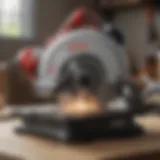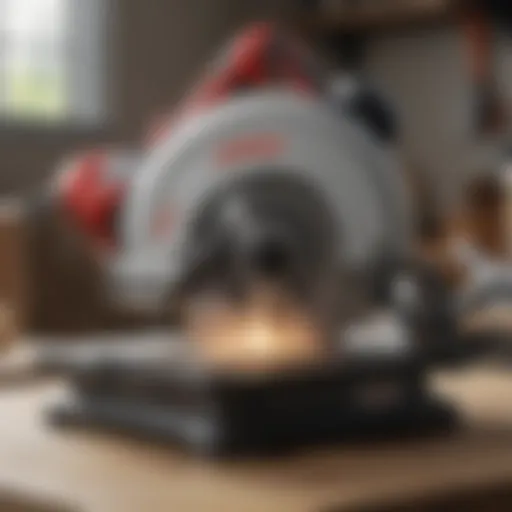The Essential Role of a 9ft Garage Door Seal
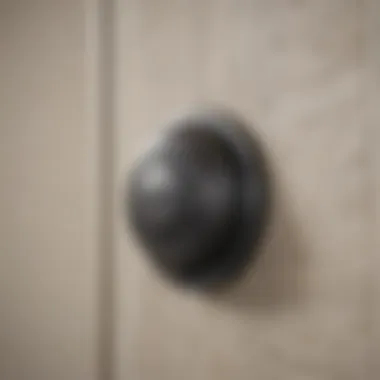

Intro
Garage doors serve various purposes in modern homes, including security, storage, and aesthetics. A fundamental aspect that often goes unnoticed is the garage door seal. A 9ft garage door seal is essential in maintaining not only the appearance of the garage but also its functionality. As homeowners explore ways to improve their living spaces, understanding the importance of this seal becomes imperative.
The seal performs a straightforward yet significant function: it acts as a barrier against external elements such as water, dust, and pests. Consequently, it plays an essential role in energy efficiency, ensuring that conditioned air remains inside the garage while outside conditions are kept at bay. In colder climates, it helps to prevent drafts, which in turn affects overall heating costs.
Furthermore, choosing the right garage door seal is not merely a matter of preference; it is a crucial decision that influences the longevity of the garage itself. A poor seal can lead to water damage, mold growth, and increased utility bills. Homeowners should understand the various types of seals available, including rubber, vinyl, and brush-style seals, and how each option can benefit their specific needs.
This article will discuss the significance of a 9ft garage door seal, outline common challenges homeowners might face, provide product recommendations, and detail step-by-step installation guides. By the end, readers will have a comprehensive understanding of how a simple seal can dramatically improve their garages.
Prelude to Garage Door Seals
When it comes to maintaining the integrity of a home, garage door seals play a crucial role. The main function of these seals is to create a barrier that protects the garage space from various external factors. This section aims to highlight the significance of understanding garage door seals and their broader implications on home maintenance.
Definition and Purpose
A garage door seal is specifically designed to fill the gap between the bottom of the garage door and the floor. Its material can vary, often made from rubber, vinyl, or foam, depending on the intended function and environment. The primary purpose of a seal is to prevent air leakage, thereby enhancing energy efficiency within the garage. Furthermore, these seals serve as a line of defense against rain, debris, pests, and cold drafts.
The presence of a high-quality seal is fundamental to maintaining an optimal environment. Without proper sealing, garages can become hotspots for issues like moisture accumulation and pest invasions. Thus, it is clear that the definition and role of a garage door seal extend beyond mere installation; they encapsulate essential home maintenance practices.
Importance in Home Maintenance
Effective home maintenance often hinges on minor details that are easily overlooked. Garage door seals are one such aspect that carries significant weight. They assist in honing energy efficiency by ensuring conditioned air—whether heated or cooled—remains intact. The savings on energy bills can be substantial, particularly in regions with extreme temperatures.
In addition, protecting the garage from outside elements keeps it in good condition. Moisture can lead to mold and mildew, while insects can find their way inside through unsealed gaps. Regular upkeep of these seals can save homeowners from expensive repairs and potential structural damage over time. It is, therefore, vital to recognize that investing in a quality garage door seal is not an optional duty but rather a necessary element of responsible home ownership.
"A strong garage door seal not only protects your garage but also enhances the overall comfort of your home."
Understanding the role of garage door seals provides a lens through which homeowners can assess and improve their property’s efficiency. It establishes a foundation for exploring the different types, benefits, and best practices related to the installation and maintenance of these crucial components.
Types of Garage Door Seals
Understanding the various types of garage door seals is essential. These seals serve as a barrier between the garage and the external environment. The right type can impact energy efficiency, overall security, and garage maintenance. Different seals offer unique benefits, making it crucial to choose one that suits individual needs and conditions.
Rubber Seals
Rubber seals are commonly used due to their durability and flexibility. They can withstand extreme weather conditions and provide an effective barrier against drafts, moisture, and pests. The elastic nature of rubber enables it to conform well to the floor surface, ensuring a tight seal. This adaptability makes rubber seals a favored choice among homeowners looking for reliability.
They come in various profiles, so it is important to select the correct shape to fit your garage door. Installation is generally straightforward, making it accessible for those who prefer DIY projects. Maintenance involves periodic inspections for wear; however, rubber seals can last several years if cared for properly.
Vinyl Seals
Vinyl seals are another popular option. They are typically less costly than rubber seals and provide adequate protection against drafts and moisture. The versatility of vinyl allows it to be manufactured in different sizes and thicknesses. While vinyl seals may not be as robust as rubber, they can still adequately serve many households, particularly in moderate climates.
In terms of installation, vinyl seals often come with adhesive backing, enabling easy application to the garage door's surface. It's worth noting that vinyl can become brittle over time, especially in extreme temperatures, so regular checks for integrity are recommended.
Foam Seals
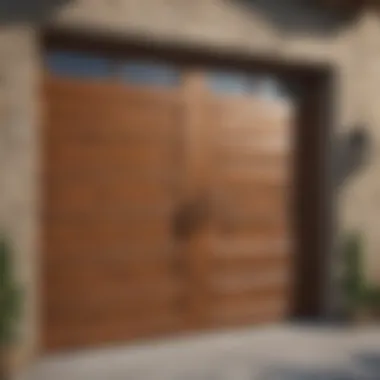

Foam seals offer unique benefits as well. They are lightweight and can be easily manipulated to fit various shapes, making them suitable for non-standard garage doors. Foam provides good insulation, helping to regulate temperature inside the garage. This can be especially helpful in maintaining the integrity of vehicles and stored items.
However, foam seals are not always durable against harsh weather elements like rain or heavy snow. They may require more frequent replacements compared to rubber or vinyl seals. Routine inspection is critical to monitor their condition. Foam seals can be affixed with adhesive tapes and are often quick to install, making them appealing for those seeking a simple solution.
Benefits of Installing a 9ft Garage Door Seal
Installing a 9ft garage door seal brings numerous advantages that cater not just to the functionality of the garage but also to the overall efficiency and safety of the home. Homeowners often underestimate the importance of these seals, viewing them as mere accessories rather than essential components of home maintenance. A well-installed garage door seal improves energy efficiency, offers weather protection, and prevents pests from invading the space. Understanding these benefits can help homeowners make informed decisions about their garage needs.
Energy Efficiency
A primary benefit of installing a 9ft garage door seal is energy efficiency. This aspect is critical, especially for households striving to reduce energy costs. The seal acts as a barrier, preventing cold air from entering during the winter and keeping the cool air inside during hot summers. Without a proper seal, homeowners may face increased energy bills due to inefficient heating and cooling. The energy lost can impact not just the garage but the entirety of the home. Moreover, a properly sealed garage helps maintain a stable temperature for items stored within, such as tools or vehicles, which can become damaged if exposed to extreme temperatures.
Weather Protection
Weather protection is another significant advantage. Harsh weather can cause significant damage to garages that lack adequate sealing. Rain and snow can seep in, leading to moisture buildup. This creates a conducive environment for mold and mildew, which can adversely affect the air quality. Furthermore, a good seal wards off strong winds that might force debris into the garage. By safeguarding against weather-induced damage, homeowners can extend the lifespan of their garage and its contents. For individuals living in areas prone to heavy rain or snow, investing in a quality garage door seal becomes even more crucial.
Pest Prevention
Pest prevention is often overlooked, yet it holds considerable importance. A 9ft garage door seal acts as a deterrent against unwanted pests. Rodents and insects can easily find their way into unsealed spaces. This not only poses health risks but also may lead to property damage as pests chew through wires or insulation. By sealing the garage door, homeowners create a barrier that helps keep these creatures outside. In situations where garages are frequented by people, such as during summer outdoor activities, maintaining a pest-free environment becomes vital.
A well-installed garage door seal is more than just a component; it is an integral part of a proactive home maintenance strategy.
Selecting the Right Seal for Your Garage Door
Choosing the appropriate seal for your garage door is crucial. A good seal not only keeps out unwanted elements but can also improve the overall functionality and security of your garage. Understanding the nuances of seal selection can help homeowners make informed choices that enhance long-term satisfaction. It involves measuring dimensions, evaluating the local climate, and considering how the garage is used.
Measuring Your Garage Door
To select the right seal, accurate measurements of your garage door are essential. Begin by measuring the width and height of the door. Use a tape measure for precision. Most standard garage doors are 7 to 9 feet in height. Understand that slight variations can occur, so it is advisable to measure the door at multiple points. This ensures you get the most accurate reading. If you're unsure, consult with a professional.
Evaluating Climate Conditions
The climate in your area plays a major role in the type of seal you should choose. For instance, regions with extreme weather conditions may require more durable materials to withstand harsh elements. In colder climates, materials with better insulation might be necessary to prevent heat loss. Meanwhile, warmer regions may benefit from seals designed to keep hot air out. Analyze local weather patterns and select seals that best suit your environmental needs.
Considering Garage Usage
How you use your garage also impacts your choice of seal. If your garage serves as a workspace, selecting a seal that minimizes dust entry would be wise. Conversely, if the garage is primarily a storage area, a seal that protects against moisture and pests could be critical. Consider what goes in and out of the garage. Evaluate if you might frequently access it or if it remains closed most of the time. Each usage scenario dictates specific seal features and materials.
"The right garage door seal can significantly impact energy efficiency, security, and garage longevity."
By thoroughly measuring your door, evaluating climate conditions, and considering how you use your garage, you can make an informed decision on the best seal. These steps lay a solid foundation for choosing a seal that optimally benefits your home.
Installation Procedures for Garage Door Seals
Installing a garage door seal is a task that should not be overlooked. It offers multiple advantages, such as improving energy efficiency and protecting against unwanted elements. Proper installation ensures that the seal functions as intended. This section provides guidance on tools needed, a step-by-step installation guide, and common pitfalls that can be avoided.
Tools Required
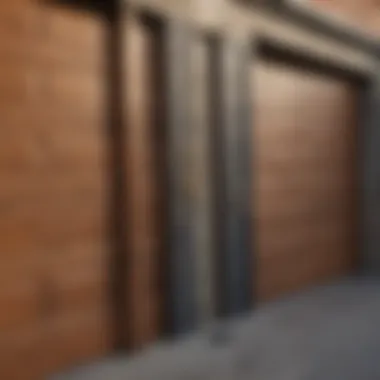

To begin the installation process, having the right tools is essential. Here is a list of useful items you will need:
- Measuring tape: To ensure accurate measurements of your garage door.
- Utility knife: For cutting the seal to the required length.
- Caulking gun: Useful if adhesive is required for installation.
- Screwdriver: Generally a Phillips or flathead, depending on your seal type.
- Paint scraper: To prepare the area where the seal will be attached, ensuring it is free of debris.
Step-by-Step Installation Guide
Installing a garage door seal doesn’t take much time, but it does require careful attention to detail. Follow these steps for a successful installation:
- Measure the Garage Door: Use the measuring tape to determine the width and height of the door. Ensure measurements are accurate.
- Choose the Seal Type: Depending on your preferences and local weather conditions, select the style of seal that fits best.
- Cut the Seal: Using the utility knife, cut the seal to size. Make sure it fits nicely along the edges of the door.
- Prepare the Door Frame: Use the paint scraper to clean off any old sealant or debris. A clean surface is crucial for adhesion.
- Attach the Seal: Depending on the type of seal, insert it into the designated groove or apply adhesive. Use the caulking gun if adhesive is needed.
- Test the Seal: Once installed, close the garage door to check for proper fit. Adjust as needed for optimal operation.
Common Installation Pitfalls
Being aware of potential mistakes can save time and frustration. Here are some common pitfalls:
- Improper Measurements: Not measuring your door accurately can lead to a poorly fitting seal.
- Ignoring Surface Preparation: Failing to clean the installation area can result in poor adhesion.
- Using Wrong Tools: Using inappropriate tools may hinder the installation process and affect seal performance.
It's essential to remember that a well-installed garage door seal can lead to long-lasting benefits, including energy savings and enhanced security.
By following these guidelines, installing a garage door seal can be simple and effective. Taking the time to do it right is worthwhile for the benefits it provides.
Impact of Garage Door Seals on Security
Garage door seals play a vital role in enhancing the overall security of your home. While many homeowners often consider garage door seals primarily for their insulation and energy efficiency benefits, their contribution to security cannot be overlooked. A well-installed garage door seal can reflect significant security improvements, helping to protect valuable belongings and maintain a sense of safety within the home.
Enhanced Security Features
An effective garage door seal acts as a barrier against unauthorized access. By ensuring a tight seal between the garage door and the ground, it minimizes the risk of tampering. Many modern garage door seals come equipped with added features such as reinforced materials, which can resist cutting and breaking. This enhances the door’s overall durability and provides an additional layer of security against attempts to gain entry.
Moreover, certain high-quality seals incorporate locking mechanisms or other advanced solutions that thwart intrusion efforts. These seals can also discourage common break-in methods, Swift breaking often involves prying open gaps between the door and frame. A robust seal reduces these gaps, thereby lowering the chance of forced entry. Ensuring that your garage door seal meets contemporary security standards is key to safeguarding your property.
Reducing Entry Points for Intruders
A well-fitted garage door seal effectively reduces the entry points available for intruders. Many burglars capitalize on vulnerable areas, such as gaps or openings. When installed correctly, a 9ft garage door seal minimizes potential weak points by creating a barrier that is difficult to breach.
- Prevents easy access: Without seals, many garage doors can be pried open or manipulated, leading to unauthorized entry.
- Improves overall home security: Intruders are less likely to target a garage with an effective seal, as it poses more challenges.
- Deters potential threats: A visible and secure seal acts as a deterrent, signaling to intruders that a property is well-protected.
In essence, a dedicated focus on the quality and fitting of your garage door seal can play a substantial part in your home security strategy. Regular checking of these seals can help ensure they remain effective over time.
Remember: Investing in a high-quality garage door seal is not just about energy savings or weatherproofing; it's also an essential step toward fortifying your home against intruders.
Maintenance Tips for Garage Door Seals
Maintaining a 9ft garage door seal is essential for ensuring not only the longevity of the seal itself but also for maximizing its benefits. Regular upkeep can prevent minor issues from escalating into major problems. Homeowners often overlook this aspect; however, investing time in maintenance pays off significantly in the long run. Proper maintenance enhances energy efficiency, fortifies security, and improves overall garage conditions.
Routine Inspections
Routine inspections of your garage door seal are fundamental to maintaining its integrity. It is advisable to check the seal at least once a season. During these inspections, look for any signs of damage or displacement. Pay close attention to the edges where the seal meets the garage door and the floor. Inspect for cracks, tears, or any gaps that could compromise performance. Identifying faults early can prevent water and pests from entering your garage. Mark your calendar to remind yourself. A simple inspection can save a lot of trouble later.
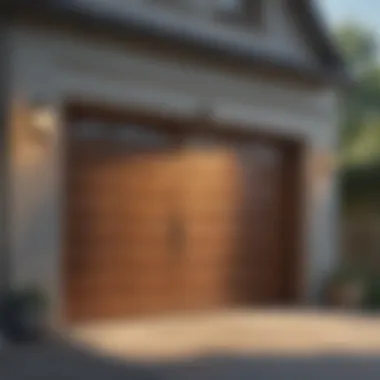

Cleaning Procedures
Keeping the garage door seal clean is equally important. Dirt and grime can accumulate over time, affecting how well the seal adheres to the door and floor. Clean the seal using a mild soap solution and a soft cloth or sponge. Avoid abrasive cleaners that could damage the material. Make sure to rinse it thoroughly to remove soap residues. Regular cleaning helps maintain flexibility and functionality, allowing the seal to perform effectively across various seasons.
Signs of Wear and Tear
Awareness of the signs of wear and tear can be beneficial for homeowners. Common indicators include visible cracks, tears, or the seal becoming brittle. If the seal appears to have shrunk or become misaligned with the door frame, it may need replacement. Other signs could include drafts or water seepage during inclement weather. If you notice any of these issues, it is important to address them promptly. Ignoring these signs can lead to more significant damage and increased costs down the road.
"Proactive maintenance can extend the life of your garage door seal, preventing costly repairs and enhancing energy efficiency."
In summary, maintenance of a 9ft garage door seal may seem like a small task, but it has a substantial impact on comfort and safety at home. Through routine inspections, cleaning procedures, and awareness of wear and tear, homeowners can ensure that their garage door seals continue to function effectively.
Cost Considerations
When considering any home improvement project, cost plays a vital role. The investment in a 9ft garage door seal may initially seem trivial compared to other home improvements. However, it is essential to recognize that this is not just a simple purchase but a strategic decision. This section explores the financial implications of installing a garage door seal, examining both the initial investment and potential long-term savings for homeowners.
Initial Investment
The first financial aspect that homeowners must assess is the initial cost of purchasing and installing a 9ft garage door seal. Prices for garage door seals can vary based on the type, quality, and brand chosen. For instance, rubber seals tend to be more durable but may also carry a higher price tag compared to vinyl or foam options. When budgeting for this project, it is crucial to factor in the costs of additional materials if needed, such as adhesive or tools for installation.
Furthermore, professional installation can add to the initial outlay. Homeowners should weigh the benefits of DIY versus hiring a professional. While a DIY installation might save money, a poorly installed seal may lead to further costs down the line due to increased energy bills or damages caused by pests and moisture.
"Investing in the right garage door seal can protect your home from weather damage and pests. It's not just a cost; it's an investment in your property."
Long-Term Savings
The second consideration revolves around long-term savings that can result from installing a garage door seal. By effectively sealing the garage door, homeowners can significantly improve energy efficiency. This translates into reduced heating and cooling costs, as less air escapes through cracks and gaps.
Additionally, there are savings linked to maintenance and repairs. A well-installed seal protects against moisture and pests, which can lead to costly repairs over time. Homeowners might avoid dealing with water damage, mold, or invasion from rodents.
It is also worth noting that a proper seal enhances the lifespan of the garage door itself. When the door is protected from the elements, it is less prone to rust and wear, which can save on replacement costs.
In summary, while the upfront investment in a 9ft garage door seal might raise some eyebrows, the long-term benefits often outweigh the initial costs, making it a wise economic choice for any homeowner.
Final Thoughts
In concluding this exploration of the 9ft garage door seal, it is critical to recognize its multifaceted role in ensuring the overall efficiency and safety of any garage space. This seal does more than merely function as a barrier against the elements; it offers a range of benefits that contribute to the longevity of both the garage and its contents. Proper installation and maintenance of the seal are paramount. Without attention to these details, even the best-seal can fail to perform as intended, leading to issues such as increased energy costs and potential infiltration of pests.
The efficient design of a 9ft seal can greatly improve energy conservation efforts within your garage, translating into noticeable savings on utility bills. This aspect is particularly important in climates with fluctuating temperatures, as insulation becomes a priority for protecting both the garage and the living spaces adjacent to it.
From a maintenance perspective, regular checks and cleaning can significantly extend the lifespan of your garage door seal. Homeowners should be engaged in routine inspections to identify wear and tear before they develop into larger problems. This proactive approach not only saves money in the long term but also fosters a sense of responsibility toward home upkeep that benefits both the property and its occupants.
As such, the investment in a quality 9ft garage door seal is not just an expenditure; it is a value proposition that encompasses safety, efficiency, and maintenance advantages that appeal to any homeowner.
Summary of Key Points
- Energy Efficiency: A 9ft garage door seal effectively minimizes heat transfer, helping to maintain preferred temperatures and reducing energy costs.
- Weather Protection: It acts as a buffer against rain, snow, and wind, keeping the garage dry and stable regardless of external conditions.
- Pest Prevention: A reliable seal decreases the risk of unwanted creatures entering the garage, ensuring that stored items remain protected.
- Cost-Effectiveness: Though there may be initial costs in purchasing and installing a garage door seal, the long-term savings make it a wise investment.
- Maintenance Needs: Engaging in routine checks and cleaning of the garage door seal is necessary to ensure its continued efficacy.
Encouraging Proactive Maintenance
To reap the benefits of a 9ft garage door seal, commitment to proactive maintenance is essential. Homeowners should regularly inspect the seal for signs of wear. Look for cracks, gaps, or any material degradation.
Cleaning the seal should become a part of seasonal chores. Simple soap and water can be effective in removing dirt and grime that may hinder the seal’s effectiveness. In addition to looking for physical damage, pay attention to the overall functionality of the garage door system. A well-maintained attic vent can also support the health of the garage environment.
If loss of energy efficiency or increased pest activity is detected, it may signal that the time has come for a replacement. Delaying this necessary action could lead to costly repairs or replacements elsewhere due to possible water damage or energy loss.
